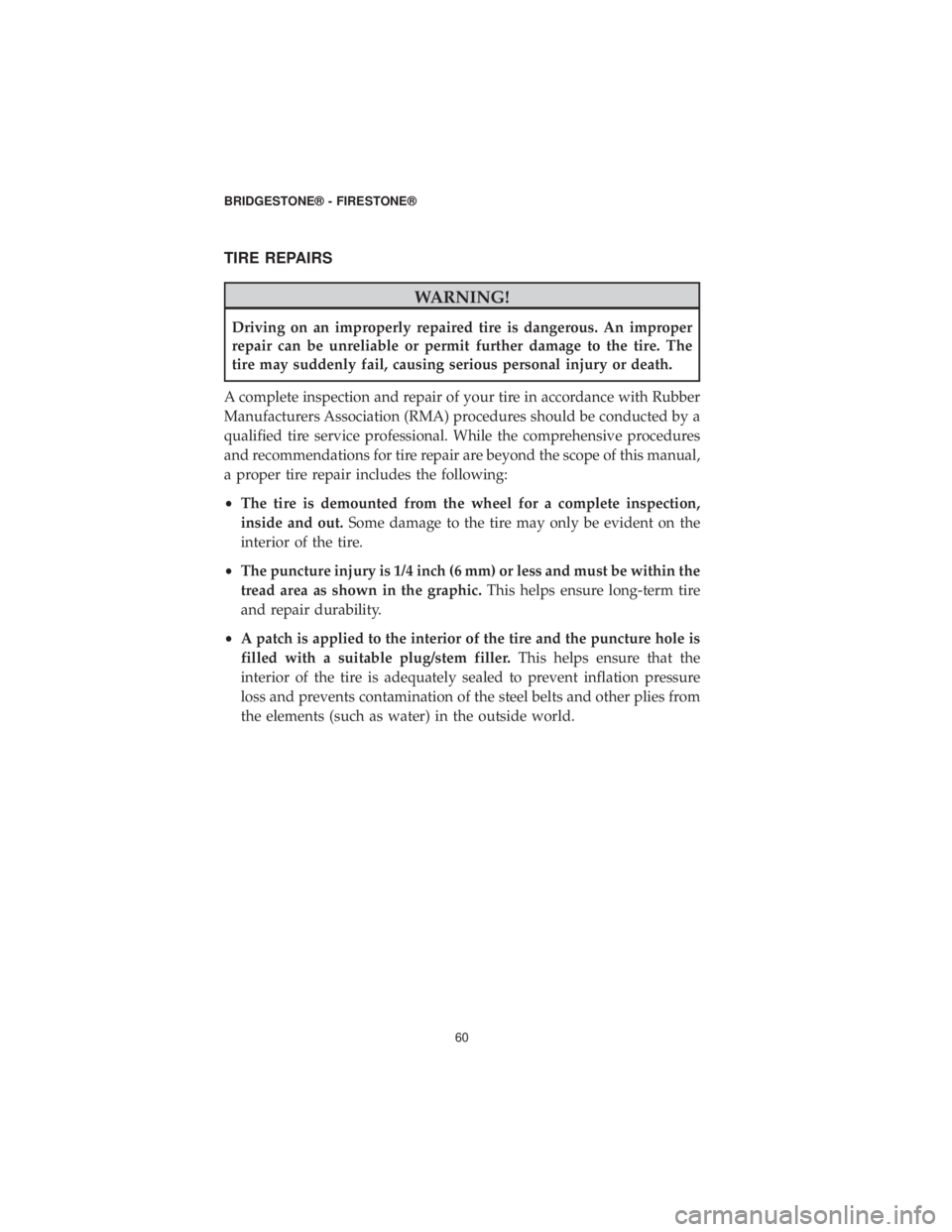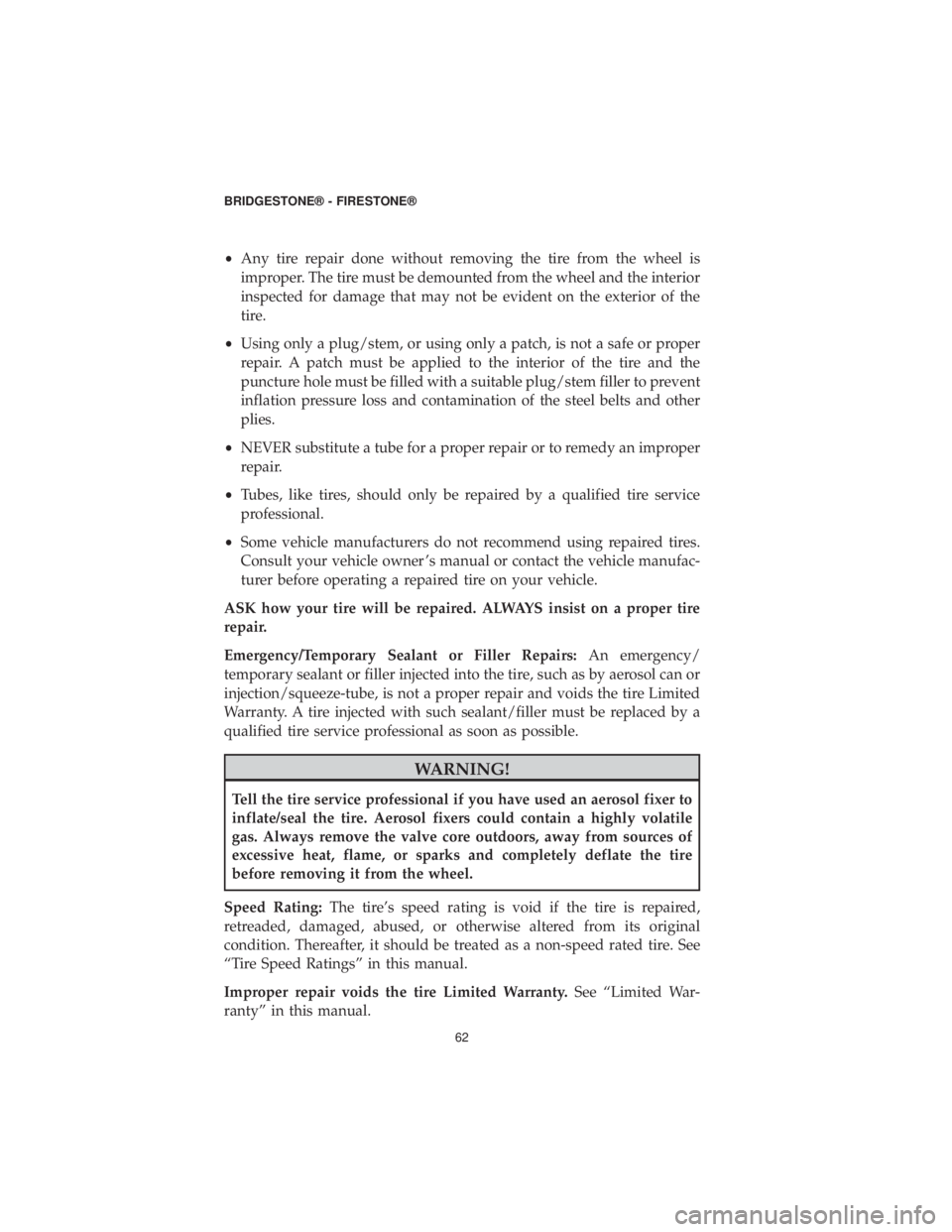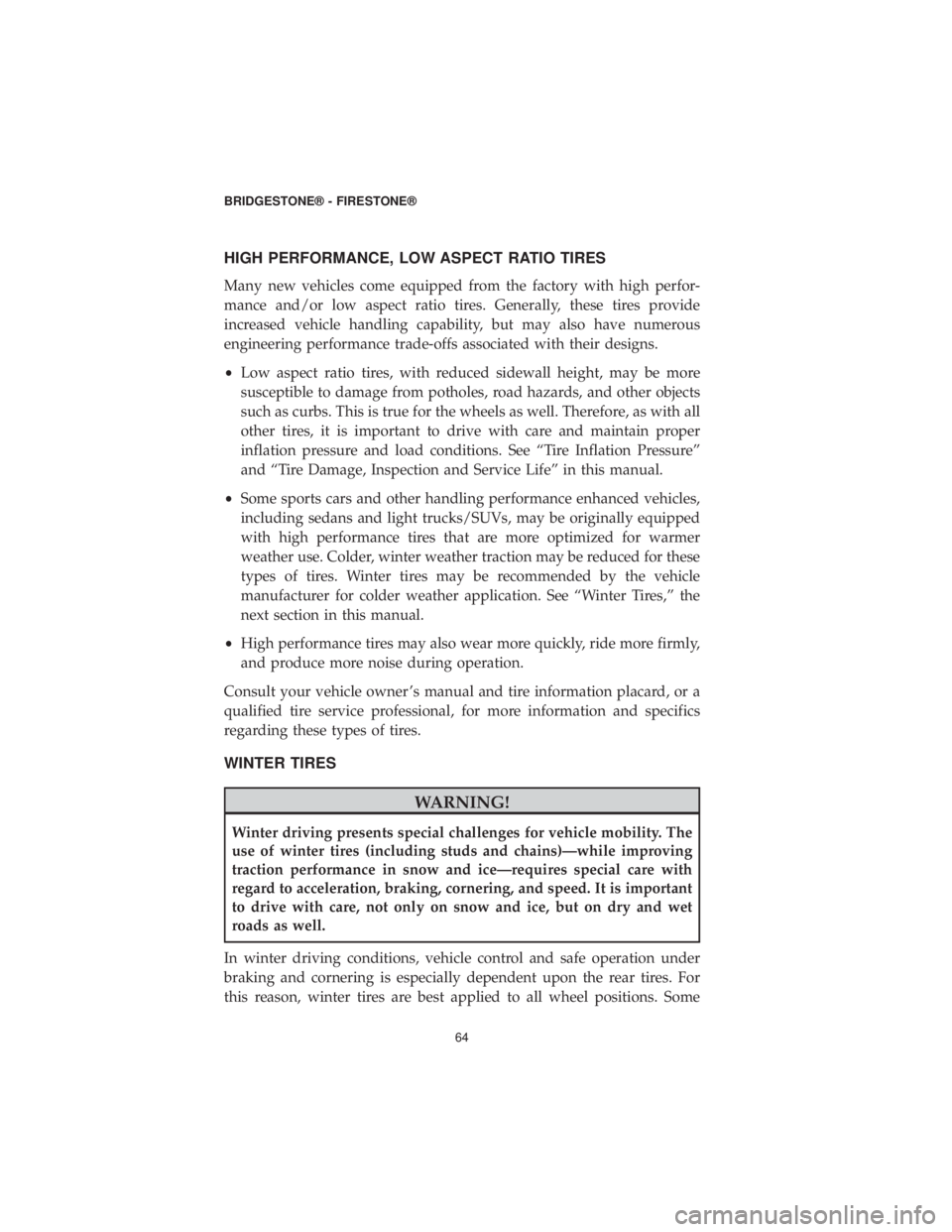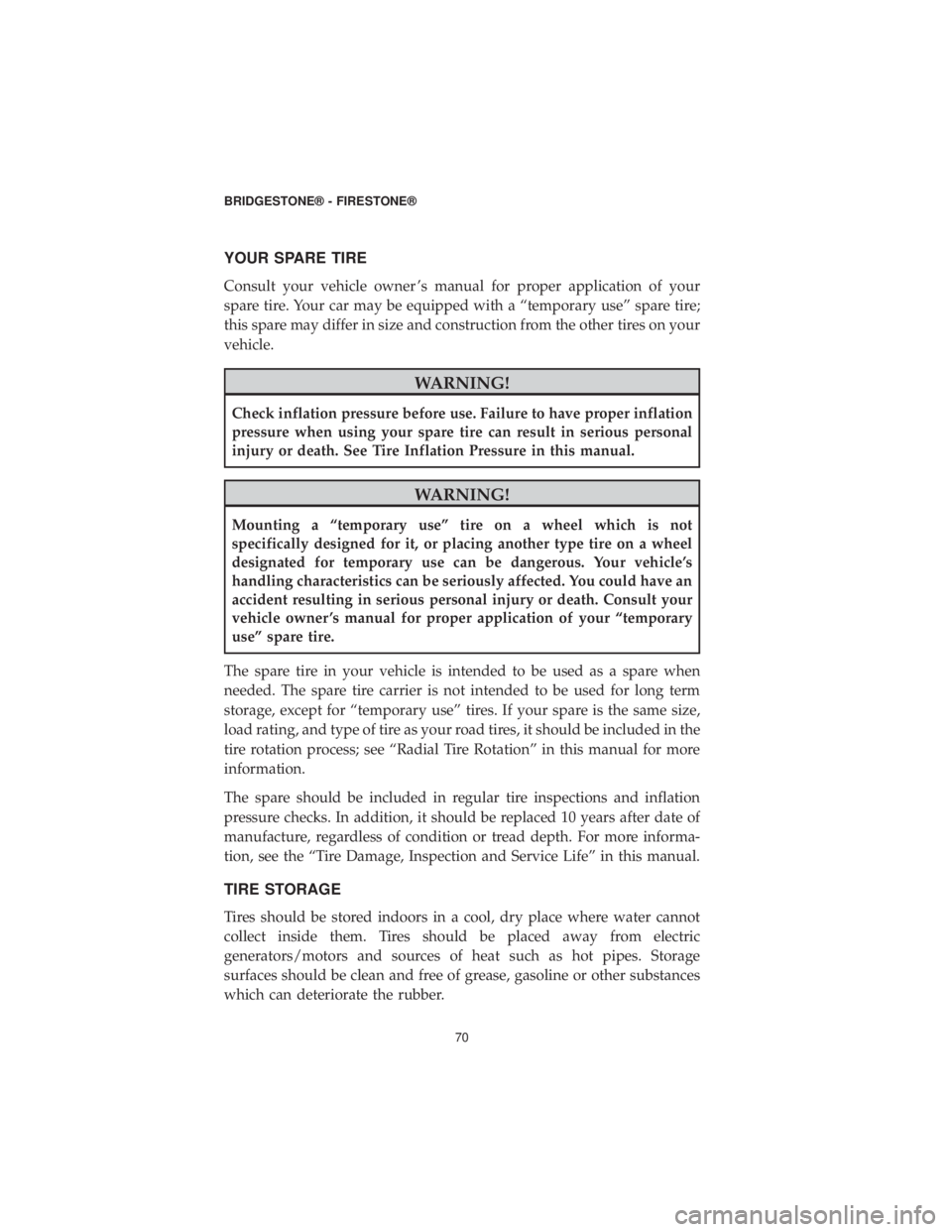2019 DODGE DURANGO SRT wheel
[x] Cancel search: wheelPage 61 of 270

TIRE REPAIRS
WARNING!
Driving on an improperly repaired tire is dangerous. An improper
repair can be unreliable or permit further damage to the tire. The
tire may suddenly fail, causing serious personal injury or death.
A complete inspection and repair of your tire in accordance with Rubber
Manufacturers Association (RMA) procedures should be conducted by a
qualified tire service professional. While the comprehensive procedures
and recommendations for tire repair are beyond the scope of this manual,
a proper tire repair includes the following:
• The tire is demounted from the wheel for a complete inspection,
inside and out. Some damage to the tire may only be evident on the
interior of the tire.
• The puncture injury is 1/4 inch (6 mm) or less and must be within the
tread area as shown in the graphic. This helps ensure long-term tire
and repair durability.
• A patch is applied to the interior of the tire and the puncture hole is
filled with a suitable plug/stem filler. This helps ensure that the
interior of the tire is adequately sealed to prevent inflation pressure
loss and prevents contamination of the steel belts and other plies from
the elements (such as water) in the outside world.
BRIDGESTONE® - FIRESTONE®
60
Page 63 of 270

•Any tire repair done without removing the tire from the wheel is
improper. The tire must be demounted from the wheel and the interior
inspected for damage that may not be evident on the exterior of the
tire.
• Using only a plug/stem, or using only a patch, is not a safe or proper
repair. A patch must be applied to the interior of the tire and the
puncture hole must be filled with a suitable plug/stem filler to prevent
inflation pressure loss and contamination of the steel belts and other
plies.
• NEVER substitute a tube for a proper repair or to remedy an improper
repair.
• Tubes, like tires, should only be repaired by a qualified tire service
professional.
• Some vehicle manufacturers do not recommend using repaired tires.
Consult your vehicle owner ’s manual or contact the vehicle manufac-
turer before operating a repaired tire on your vehicle.
ASK how your tire will be repaired. ALWAYS insist on a proper tire
repair.
Emergency/Temporary Sealant or Filler Repairs: An emergency/
temporary sealant or filler injected into the tire, such as by aerosol can or
injection/squeeze-tube, is not a proper repair and voids the tire Limited
Warranty. A tire injected with such sealant/filler must be replaced by a
qualified tire service professional as soon as possible.
WARNING!
Tell the tire service professional if you have used an aerosol fixer to
inflate/seal the tire. Aerosol fixers could contain a highly volatile
gas. Always remove the valve core outdoors, away from sources of
excessive heat, flame, or sparks and completely deflate the tire
before removing it from the wheel.
Speed Rating: The tire’s speed rating is void if the tire is repaired,
retreaded, damaged, abused, or otherwise altered from its original
condition. Thereafter, it should be treated as a non-speed rated tire. See
“Tire Speed Ratings” in this manual.
Improper repair voids the tire Limited Warranty. See “Limited War-
ranty” in this manual.
BRIDGESTONE® - FIRESTONE®
62
Page 64 of 270

RFT (Run-Flat Technology) Tires:In addition to the above, there are
recommendations specific to the repair of RFT tires; see “RFT Tires with
Run-Flat Technology” in this manual.
TIRE MOUNTING AND OTHER SERVICING
WARNING!
Removing and replacing tires on wheels can be dangerous.
Attempting to mount tires with improper tools or procedures may
result in a tire explosion causing serious personal injury or death.
This is only a job for a qualified tire service professional. Never
perform tire service procedures without proper training, tools, and
equipment.
This manual is not intended to provide proper training or service
procedures for tire mounting, demounting, balancing, rotation, or
repair. Please leave these tasks to qualified tire service professionals.
For your safety and that of others:
• Always stand well clear of any tire mounting operation. This is
especially important when the service operator inflates the tire. If the
tire has been improperly mounted, it may burst with explosive force
causing serious personal injury or death.
• Tires must match the width and diameter requirements of the wheels.
For example, 16 inch diameter tires must only be mounted to 16 inch
diameter wheels. Radial tires must only be mounted to wheels
approved for radial tires.
• Wheels must be free of cracks, dents, chips, and rust. Tires must be free
of bead damage, cuts, and punctures.
• Never inflate a tire beyond 40 psi (275 kPa) to seat the beads. Be
absolutely certain beads are fully seated before adjusting inflation
pressure to the level recommended for vehicle operation.
• Never put flammable substances in tire/wheel assemblies at any time.
Never put any flammable substance into a tire/wheel assembly and
attempt to ignite to seat the beads.
• Always stand well away from the work area when tires are being spin
balanced either on or off the vehicle.
BRIDGESTONE® - FIRESTONE®
63
Page 65 of 270

HIGH PERFORMANCE, LOW ASPECT RATIO TIRES
Many new vehicles come equipped from the factory with high perfor-
mance and/or low aspect ratio tires. Generally, these tires provide
increased vehicle handling capability, but may also have numerous
engineering performance trade-offs associated with their designs.
•Low aspect ratio tires, with reduced sidewall height, may be more
susceptible to damage from potholes, road hazards, and other objects
such as curbs. This is true for the wheels as well. Therefore, as with all
other tires, it is important to drive with care and maintain proper
inflation pressure and load conditions. See “Tire Inflation Pressure”
and “Tire Damage, Inspection and Service Life” in this manual.
• Some sports cars and other handling performance enhanced vehicles,
including sedans and light trucks/SUVs, may be originally equipped
with high performance tires that are more optimized for warmer
weather use. Colder, winter weather traction may be reduced for these
types of tires. Winter tires may be recommended by the vehicle
manufacturer for colder weather application. See “Winter Tires,” the
next section in this manual.
• High performance tires may also wear more quickly, ride more firmly,
and produce more noise during operation.
Consult your vehicle owner ’s manual and tire information placard, or a
qualified tire service professional, for more information and specifics
regarding these types of tires.
WINTER TIRES
WARNING!
Winter driving presents special challenges for vehicle mobility. The
use of winter tires (including studs and chains)—while improving
traction performance in snow and ice—requires special care with
regard to acceleration, braking, cornering, and speed. It is important
to drive with care, not only on snow and ice, but on dry and wet
roads as well.
In winter driving conditions, vehicle control and safe operation under
braking and cornering is especially dependent upon the rear tires. For
this reason, winter tires are best applied to all wheel positions. Some
BRIDGESTONE® - FIRESTONE®
64
Page 66 of 270

vehicles have specific recommendations regarding winter tire use; con-
sult your vehicle owner ’s manual and tire information placard.
•If winter tires are to be applied to the front axle of any vehicle, they
must also be applied to the rear axle for safe operation. This applies to
all passenger cars and light trucks, including front wheel drive, 4x4,
and all-wheel-drive vehicles.
• If winter tires are to be applied to the rear axle of any vehicle, it is
recommended that they also be installed on the front axle.
• It is generally acceptable to apply a tire with a lower speed rating than
your original tires for use in winter weather conditions; however,
speed should be reduced accordingly. All winter tires should be the
same speed rating. See “Tire Speed Ratings” in this manual.
• Winter tires used in warmer, summer weather conditions may wear
more rapidly.
• Studded winter tires follow the same recommendations as above;
consult a qualified tire service professional for information regarding
any seasonal restrictions.
TIRE MIXING
WARNING!
Driving your vehicle with an improper mix of tires is dangerous.
Your vehicle’s handling characteristics can be seriously affected. You
could have an accident resulting in serious personal injury or death.
Consult your vehicle owner ’s manual and a qualified tire service
professional for proper tire replacement.
HIGH SPEED DRIVING
WARNING!
Driving at high speed is dangerous and can cause a vehicle accident,
including serious personal injury or death.
• Regardless of the speed and handling capabilities of your car and its
tires, a loss of vehicle control can result from exceeding the maximum
speed allowed by law or warranted by traffic, weather, vehicle, or road
conditions.
BRIDGESTONE® - FIRESTONE®
65
Page 70 of 270

If your spare is the same size, load rating, and type of tire as your road
tires, it should be included in the tire rotation process. For vehicles with
a “full-size” spare, the following rotation patterns may be used:
NOTE:
•Never include a “temporary use” spare tire in the rotation.
• Tires with directional tread patterns must be rotated so the direction of
revolution does not change; this may require demounting/mounting
the tires.
• Special attention should be given if your vehicle is equipped with a
Tire Pressure Monitoring System (TPMS). Rotation of your tires may
affect the system; consult your vehicle owner ’s manual or a qualified
tire service professional.
• Some vehicles may have different size tires/wheels on front and rear
which would restrict rotation. Always check and follow the vehicle
manufacturer ’s rotation recommendation.
• To use a full-size spare in the rotation pattern on vehicles with dual
rear wheels, consult your vehicle owner ’s manual for the recom-
mended procedures or consult the vehicle manufacturer.
BRIDGESTONE® - FIRESTONE®
69
Page 71 of 270

YOUR SPARE TIRE
Consult your vehicle owner ’s manual for proper application of your
spare tire. Your car may be equipped with a “temporary use” spare tire;
this spare may differ in size and construction from the other tires on your
vehicle.
WARNING!
Check inflation pressure before use. Failure to have proper inflation
pressure when using your spare tire can result in serious personal
injury or death. See Tire Inflation Pressure in this manual.
WARNING!
Mounting a “temporary use” tire on a wheel which is not
specifically designed for it, or placing another type tire on a wheel
designated for temporary use can be dangerous. Your vehicle’s
handling characteristics can be seriously affected. You could have an
accident resulting in serious personal injury or death. Consult your
vehicle owner ’s manual for proper application of your “temporary
use” spare tire.
The spare tire in your vehicle is intended to be used as a spare when
needed. The spare tire carrier is not intended to be used for long term
storage, except for “temporary use” tires. If your spare is the same size,
load rating, and type of tire as your road tires, it should be included in the
tire rotation process; see “Radial Tire Rotation” in this manual for more
information.
The spare should be included in regular tire inspections and inflation
pressure checks. In addition, it should be replaced 10 years after date of
manufacture, regardless of condition or tread depth. For more informa-
tion, see the “Tire Damage, Inspection and Service Life” in this manual.
TIRE STORAGE
Tires should be stored indoors in a cool, dry place where water cannot
collect inside them. Tires should be placed away from electric
generators/motors and sources of heat such as hot pipes. Storage
surfaces should be clean and free of grease, gasoline or other substances
which can deteriorate the rubber.
BRIDGESTONE® - FIRESTONE®
70
Page 73 of 270

RFT TIRES WITH RUN-FLAT TECHNOLOGY
If your vehicle is equipped with
Bridgestone or Firestone brand RFT
tires, this chapter presents specific
maintenance and safety issues asso-
ciated with these tires that are in addition to those covered elsewhere in
this manual.
What is RFT? Run-Flat Technology tires are extraordinary tires that
utilize specially designed components to temporarily support your
vehicle in the event of inflation pressure loss, such as from a puncture.
This gives you the ability to drive to a convenient and safe location to
change your tire (if equipped with a spare) or have it inspected for
possible repair or replacement.
Naturally, certain run-flat and low pressure operating limitations apply,
which varies according to the specific self-supporting tire design. Like all
tires, during normal operation, they must be properly inflated and
maintained. Regardless of the design or quality, no tire is indestructible.
RFT—How to Identify: Bridgestone and Firestone brand tires are
marked on the sidewalls, near the wheel, with the RFT logo (shown
above).
RFT INFLATION PRESSURE
Like other tires, RFT tires need proper inflation pressure maintenance for
safe operation and to achieve the maximum tire life and performance.
Check inflation pressures monthly and before long trips or carrying extra
weight. Use an accurate tire gauge and check pressures when the tires are
cold. Follow the vehicle manufacturer ’s recommendation for inflation
pressure settings as indicated on the vehicle tire information placard
and/or in the vehicle owner ’s manual. Do not forget the spare, if
applicable. See “Tire Inflation Pressure” in this manual.
TIRE PRESSURE MONITORING SYSTEM (TPMS)
A functioning tire pressure monitoring system (TPMS) must be used with
your RFT tires. Because these tires ride so well even without inflation
pressure, the TPMS may be necessary to alert you of an inflation pressure
loss condition. When alerted, follow the instructions in your vehicle
owner ’s manual and see “Run-Flat or Low Tire Pressure Operation,” the
following section in this manual.
BRIDGESTONE® - FIRESTONE®
72